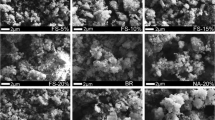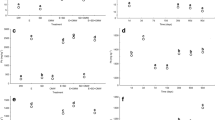Abstract
Natural organic acids may play an important role in influencing the mobility of toxic contaminants in the environment. The mobilization of arsenic (As) and heavy metals from an oxidized Pb–Zn mine tailings sample in the presence of three low-molecular-weight organic acids, aspartic acid, cysteine, and succinic acid, was investigated at a mass ratio of 10 mg organic additive/g mine tailings in this study. The effect of pH was also evaluated. The mine tailings sample, containing elevated levels of As (2,180 mg/kg), copper (Cu, 1,100 mg/kg), lead (Pb, 12,860 mg/kg), and zinc (Zn, 5,075 mg/kg), was collected from Bathurst, New Brunswick, Canada. It was found that the organic additives inhibited As and heavy metal mobilization under acidic conditions (at pH 3 or 5), but enhanced it under neutral to alkaline conditions (at pH above 7) through forming aqueous organic complexes. At pH 11, As, Cu, Pb, and Zn were mobilized mostly by the organic additives, 45, 46, 1,660, and 128 mg/kg by aspartic acid, 31, 28, 1,040, and 112 mg/kg by succinic acid, and 53, 38, 2,020, and 150 mg/kg by cysteine, respectively, whereas those by distilled water were 6, 16, 260, and 52 mg/kg, respectively. It was also found that the mobilization of As and the heavy metals was closely correlated, and both were closely correlated to Fe mobilization. Arsenic mobilization by the three LMWOAs was found to be consistent with the order of the stability of Fe–, Cu–, Pb–, and Zn–organic ligand complexes. The organic acids might be used potentially in the natural attenuation and remediation of As and heavy metal–contaminated sites.




Similar content being viewed by others
References
Abollino, O., Aceto, M., Malandrino, M., Sarzanini, C., & Mentasti, E. (2003). Adsorption of heavy metals on a Na-montmorillonite. Effect of pH and organic substances. Water Research, 37, 1619–1627.
ASTM (American Society of Testing Materials). (1970). Special procedure for testing soil and rocks for engineering purposes (D422-54). In: 1970 Annual book of ASTM standards (pp. 101–103). Philadelphia, PA: ASTM.
ASTM (American Society of Testing Materials). (1999). Standard test method for specific gravity of soils. In: Annual book of ASTM standards. Philadelphia, PA: ASTM.
Berthon, G. (1995). The stability constants of metal complexes of amino acids with polar side chains. Pure and Applied Chemistry, 67, 1117–1240.
Carter, D. L., Mortland, M. M., & Kemper, W. D. (1986). Specific surface. In A. Klute (Ed.), Methods of soil analyses: Part 1. Physical and mineralogical methods agronomy monograph (pp. 413–423). Madison, WI: Soil Science Society of America.
Christl, I., & Kretzschmar, R. (2001). Interaction of copper and fulvic acid at the hematite–water interface. Geochimica et Cosmochimica Acta, 65, 3435–3442.
Coles, C. A., & Yong, R. N. (2006). Humic acid preparation, properties and interactions with metals lead and cadmium. Engineering Geology, 85, 26–32.
Eick, M. J., Peak, J. D., & Brady, W. D. (1999). The effect of oxyanions on the oxalate-promoted dissolution of goethite. Soil Science Society of America Journal, 63, 1133–1141.
Farrah, H., & Pickering, W. F. (1978). The effect of pH and ligands on the sorption of heavy metal ions by cellulose. Australian Journal of Chemistry, 31, 1501–1509.
Frimmel, F. H. (1998). Characterization of natural organic matter as major constituents in aquatic systems. Journal of Contaminant Hydrology, 35, 201–216.
Fuller, C. C., Davies, J. A., & Waychunas, G. A. (1993). Surface chemistry of ferrihydrite: Part 2. Kinetics of arsenate adsorption and coprecipitation. Geochimica et Cosmochimica Acta, 57, 2271–2282.
Gharib, F., Zare, K., Taghvamanesh, A., & Monajjemi, M. (2001). Ionic strength dependence of formation constants: Complexation of Mo(VI) with aspartic acid. Journal of Chemical and Engineering Data, 46, 1140–1144.
Gillman, G. P., & Sumpter, E. A. (1986). Modification to the compulsive exchange method for measuring exchange characteristics of soils. Australia Journal of Soil Research, 24, 61–66.
Ikhsan, J., Wells, J. D., Johnson, B. B., & Angove, M. J. (2004). The effect of aspartic acid on the binding of transition metals to kaolinite. Journal of Colloid and Interface Science, 273, 6–13.
Manning, B. A., & Goldberg, S. (1997). Adsorption and stability of arsenic(III) at the clay mineral–water interface. Environmental Science and Technology, 31, 2005–2011.
Martell, A. E., Smith, R. M. (1976–1989). Critical stability constants. Newyork: Plenum Press.
Masscheleyn, P. H., Delaune, R. D., & Patrick, W. H., Jr. (1991). Effect of redox potential and pH on arsenic speciation and solubility in a contaminated soil. Environmental Science and Technology, 25, 1414–1419.
Mulligan, C. N., Yong, R. N., & Gibbs, B. F. (2001). Heavy metal removal from sediments by biosurfactants. Journal of Hazardous Materials, 85, 111–125.
Ochs, M., Brunner, I., Stumm, W., & Cosovic, P. (1993). Effects of root exudes and humic substances on weathering kinetics. Water, Air, and Soil pollution, 68, 213–229.
Schofield, R. K., & Taylor, A. W. (1955). The measurement of soil pH. Proceedings-Soil Science Society of America, 19, 164–167.
Shaw, D. (2004). Mobility of arsenic in saturated, laboratory test sediments under varying pH conditions. In Y. N. Yong & H. R. Thomas (Eds.), Integrated management of groundwater and contaminated land (pp. 142–150). London: Thomas Telford.
Spark, K. M., Wells, J. D., & Johnson, B. B. (1997). The interaction of a humic acid with heavy metals. Australia Journal of Soil Research, 35, 89–101.
Ulrich, B. (1983). Soil acidity and its relation to acid deposition. In B. Ulrich & J. Pankrath (Eds.), Effects of accumulation of air pollutants in ecosystems (pp. 127–146). Boston: Reidel.
Unterbrunner, R., Puschenreiter, M., Sommer, P., Wieshammer, G., Tlustos, P., Zupan, M., et al. (2007). Heavy metal accumulation in trees growing on contaminated sites in Central Europe. Environmental Pollution, 148, 107–114.
Wang, S., & Mulligan, C. N. (2006a). Occurrence of arsenic contamination in Canada: Sources, behavior, and distribution. Science of the Total Environment, 366, 701–721.
Wang, S., & Mulligan, C. N. (2006b). Effect of natural organic matter on arsenic release from soil and sediments into groundwater. Environmental Geochemistry and Health, 28, 197–214.
Wang, S., & Mulligan, C. N. (2006c). Natural attenuation processes in remediating arsenic contaminated soils and groundwater. Journal of Hazardous Materials, 138, 459–470.
Wang, S., & Mulligan, C. N. (2009a). Effect of natural organic matter on arsenic mobilization from mine tailings. Journal of Hazardous Materials, 168, 721–726.
Wang, S., & Mulligan, C. N. (2009b). Enhanced mobilization of arsenic and heavy metals from mine tailings by a humic acid. Chemosphere, 74, 274–279.
Yong, R. N., Mohamed, A. M. O., & Warkentin, B. P. (1992). Principles of Contaminant Transport in Soils. Amsterdam: Elsevier.
Acknowledgments
The authors would like to acknowledge the financial support of the National Science and Engineering Research Council (NSERC) of Canada and the Concordia University Faculty of Engineering and Computer Science Faculty Support.
Author information
Authors and Affiliations
Corresponding author
Rights and permissions
About this article
Cite this article
Wang, S., Mulligan, C.N. Effects of three low-molecular-weight organic acids (LMWOAs) and pH on the mobilization of arsenic and heavy metals (Cu, Pb, and Zn) from mine tailings. Environ Geochem Health 35, 111–118 (2013). https://doi.org/10.1007/s10653-012-9461-3
Received:
Accepted:
Published:
Issue Date:
DOI: https://doi.org/10.1007/s10653-012-9461-3




